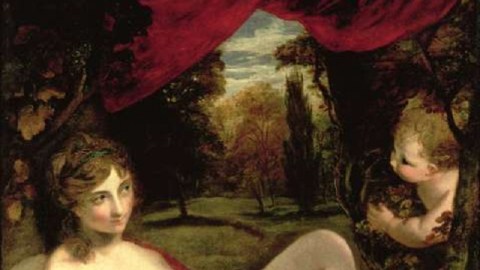Seeing Art the Way Jane Austen Saw it

On May 24, 1813, just months after publishing Pride and Prejudice, Jane Austen went to a show in search of her female hero. ”I dare say Mrs. D[arcy] will be in yellow,” Austen wrote to her sister, fully expecting to find her heroine at the event—a retrospective of the painting of Sir Joshua Reynolds, the preeminent painter to the rich and powerful of late 18th century England. Austen came away disappointed at not finding a painted equivalent to her novel’s main draw, but modern viewers won’t be disappointed by an online recreation of the exhibition titled What Jane Saw, which will draw in not just the legions of Jane Austen fans but also anyone interested in the origins of the museum blockbuster as well as the beginnings of celebrity culture and its discontents.
Prof. Janine Barchas of University of Texas at Austen, er, Austin, gathered together a team of researchers and programmers to recreate the Reynolds exhibit for the bicentennial of Austen’s trip, but even if Austen never saw the show, it would have been of historical significance. The exhibition stands as the first major retrospective of any single artist. Museums and public galleries were still relatively new phenomena in the early 19th century. In the preface to the exhibit catalogue, Richard Payne Knight praises Reynolds work both for its own merits and for its power “to call attention generally to British, in preference to Foreign Art.” Thus, this first museum blockbuster, which drew over 800 visitors per day, became war by other means. Just as every major art exhibition serves (or disserves) some agenda, this initial salvo in the blockbuster game did so unashamedly.
What Jane Saw allows you to peruse the exhibit just as Jane did, to the best of present-day knowledge. No visual record of the exhibition exists, but the researchers culled contemporary accounts and other sources to make the best approximation possible. You can, as Jane probably did, pick up the exhibition catalogue and work your way along. (The online catalogue reproduces an actual copy of the original but with helpful hyperlinks dropped in.) Or you can just stroll virtually among the three rooms of paintings, starting with the North Room (where His Majesty George III starts the show), through the Middle Room, and finishing in the South Room (where Her Majesty Queen Charlotte marks the end). Between the bewigged monarchs sit a vast array of portraits of the rich, powerful, beautiful, young, old, famous, and infamous that generated the celebrity culture Austen both celebrated and critiqued in her novels like someone flipping through People Magazine today.
Each of the 141 paintings (reproduced visually except for a few exceptions, an amazing achievement considering two centuries of dispersion) comes with helpful notes and Austen connections that assist the modern-day viewer in reading both the individual paintings and their arrangement. Was Austen a careful enough reader to recognize the subtle suggestion made by placing a wind-blown head of Shakespeare’s maddened King Lear near the Portrait of his Majesty, W.L., i.e., “Mad King George”? Did she also seen the inequity of that same king’s portrait taking the number 1 slot in the program, per protocol, over the Portrait of Mrs. Siddons as the Tragic Muse, whose subject, the acclaimed actress Sarah Siddons, reigned in terms of popularity if not political power? It’s probably safe to say that Austen, whose novels demand close, attentive reading, was a close, attentive reader herself and got most of the jokes.
Wandering virtually through the exhibition made me feel like I was perusing the Facebook page of some circa 1780s British noble: A portrait of Lady George Cavendish, W.L. shows off the typical trophy wife in a full-length pose, the Portrait of Master Henry Herbert, as infant Bacchus simultaneously shows off and embarrasses the future Second Earl of Carnarvon, the Portrait of the Duke of Orleans depicts Louis Philippe Joseph, the Duke of Chartres and later Duke of Orleans, at his gaudily uniformed manliest, complete with virile stallion to make things perfectly clear. Even without the helpful explanatory notes you can still read the signs today—these people had it all, and wanted you to know it.
Some cracks in the edifice, however, allow different messages to leak through. The Portrait of the Marchioness of Tavistock, W.L. shows Lady Elizabeth Keppel, one of Queen Charlotte’s bridesmaids, in her bridesmaid’s dress as a black female servant stands at the ready. More subtly, the Portrait of a Gentleman, aka, Captain Robert Haldane of the East India Company, alludes to the darker side of the sea-borne British Empire only by a rocky coast and crashing waves behind the figure. Both, however, made me think of Edward Said’s essay “Jane Austen and Empire” and what Austen herself thought, if anything, when standing before those portraits.
Although Jane didn’t find her Mrs. Darcy, she did find an interesting group of women beyond just the beautifully painted arm candy. Sarah Siddons, as already mentioned, set an early standard for strong, gifted women. The Portrait of Mrs. Mary Hale in the character of the Allegro shows Mary Hale as Euphrosyne, one of the Three Graces of Greek mythology. Euphrosyne personifies joy itself, and it’s not hard to imagine Mary’s own zestful personality. As the site notes, the change to “the Allegro” from the Greek connection may allude to John Milton‘s “L’Allegro,” another celebration of active and joyful living. In the Portrait of Lady Charles Spencer, Mary Beauclerk Spencer appears, quite unconventionally, not just with her horse, but also in a scarlet red riding coat with a very masculine fit. Although a long skirt saves Lady Spencer’s respectability somewhat, the rest of the portrait steals all the stereotypically masculine trappings of power (depicted in portraits of men hung close by this one, as if for emphasis).
But what would female fame be without a touch of infamy? The Portrait of Kitty Fisher as Cleopatra gives a classical touch to Catherine “Kitty” Fisher, the most famous courtesan of Reynolds’ heyday. The name “Kitty” itself became synonymous with reckless female sexuality, something, as the site notes, Austen herself used in naming the boldest of the Bennett sisters in Pride and Prejudice “Kitty.” Jane didn’t find her Mrs. Darcy at the show, but she did find the original “Kitty.” The only female nude in the exhibition appears in Venus and Cupid (shown in family-friendly detail above). To protect a single model from scandal, Reynolds created a composite Venus from face and hair of the 16-year-old daughter of his manservant and the body of a single mother found begging in the streets. To protect the innocent, the curators of the 1813 show placed it higher on the wall, above eye level. Did Jane look up? We’ll never know. I almost wish Lord Byron (the period’s bad boy, who attended the show’s opening for A-list celebrities) were standing next to her if she did.
Reynolds himself makes three self-portrait appearances in the show, all at conspicuous eye level. In the earliest portrait, dating from the 1750s, when Reynolds was taking in the Renaissance masters in Rome, Reynolds poses himself in the style of a Rembrandt self-portrait by the Old Master at around the same age of 30. In Portrait of Sir Joshua Reynolds, the most famous of all Reynolds self-portraits, he not only wears the Rembrandt-esque velvet cape and floppy hat, but poses next to a bust of Michelangelo, his favorite artist. Like many of the other paintings in this show, this portrait became a popular engraving—the public “face” that the public would know and collect. A final portrait shows Reynolds painting himself into a commission for the New College window design. Reynolds “hides” as an adoring shepherd, in a nod to the Renaissance practice of artists hiding self-portraits in larger works as a signature “hidden” in plain sight. Even before this retrospective raising Reynolds to the rank of Old Master, Reynolds never hesitated putting himself in rarified company.
What Jane Saw works on so many levels. There’s the obvious Austen appeal, stronger than usual in this Pride and Prejudice bicentennial year. But there’s also the appeal of recreating a slice of the world around Austen, which looks remarkably similar to our own, that is, infatuated with celebrity in all its forms—royal, artistic, military, monetary, infamy. The Sarah Siddons and Lady Spencer of Austen’s day may be the Lindsay Lohan and Princess Kate of today. What Jane Austen saw looks much like what we see today, but What Jane Saw teaches us, like Austen’s novels do, is to read the signs in a deeper way, lest we get caught up in the glamorous surfaces.
[Image:Sir Joshua Reynolds. Venus and Cupid (detail).]





